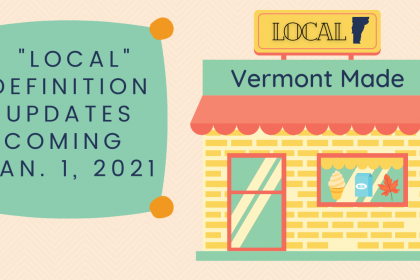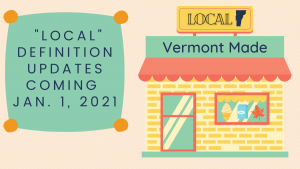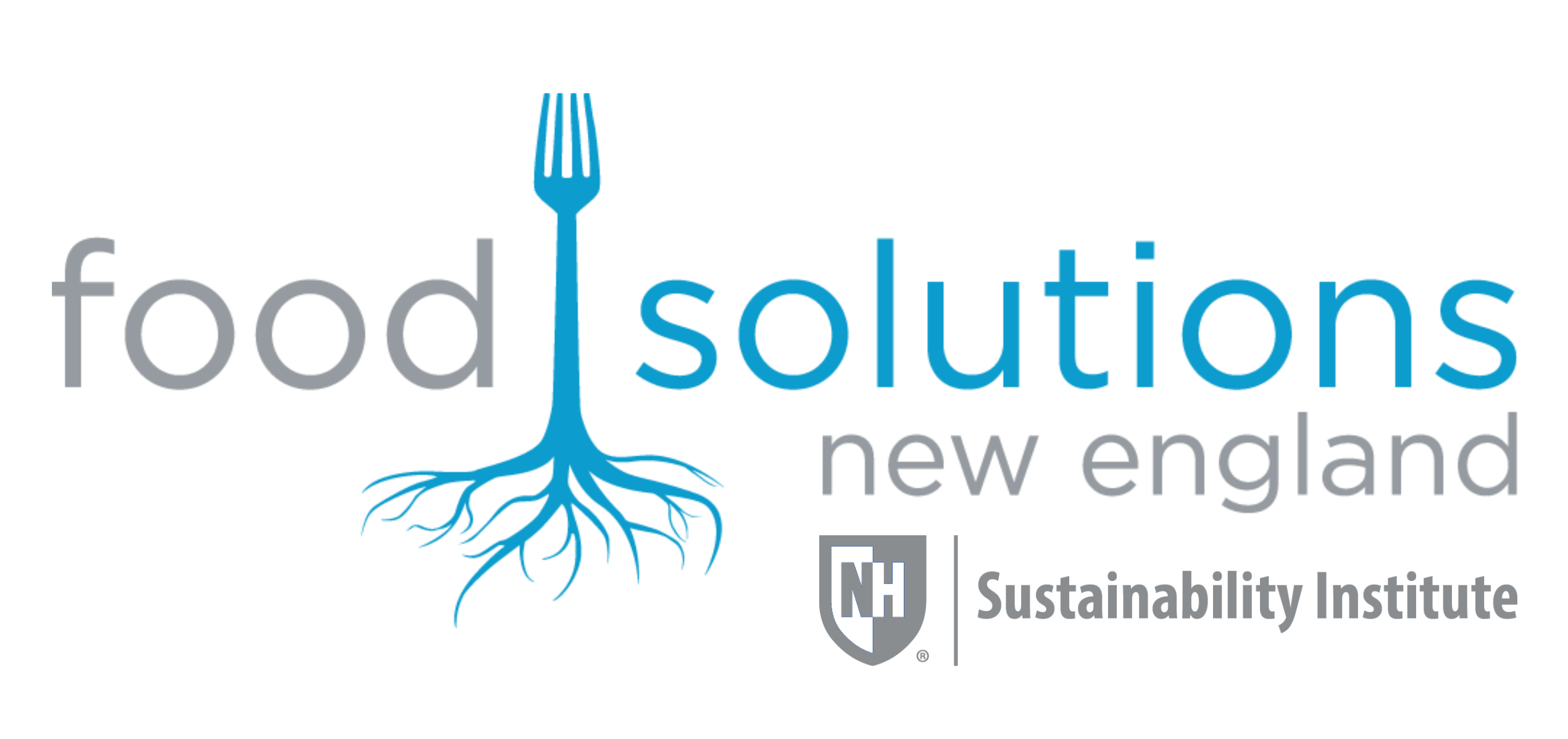
Originally published on vermontbiz.com
 Vermont Business Magazine Businesses who sell and/or market products using “local”, or equivalent terms such as “made in Vermont”, should be aware that the State of Vermont, Agency of Agriculture is updating its definition of these terms on January 1, 2021.
Vermont Business Magazine Businesses who sell and/or market products using “local”, or equivalent terms such as “made in Vermont”, should be aware that the State of Vermont, Agency of Agriculture is updating its definition of these terms on January 1, 2021.
The new definition differentiates food by category: raw agricultural products, processed foods, and unique food products. Each category has its own requirements to be considered local, including consideration of ingredients, manufacturing, and company headquarters for processed food items.
The new definition provides clearer guidance for those producing, selling, or marketing local food products. It also strengthens the local brand by creating a more meaningful and comprehensive definition for Vermont made products.
On July 2, 2020, Governor Scott signed Act 129(link is external) (H.656) into law. The legislation changed the definition of “local” and equivalent terms like “locally grown,” “local to Vermont,” and “made in Vermont” to better define Vermont food. The clarity should also help protect the value and craftsmanship of Vermont’s food and agricultural producers and processors.
The new definition makes “local” synonymous with “Vermont” with respect to food products. It also offers opportunities to celebrate Vermont’s brand and recognize the value of buying Vermont products.
Previously, the term “local” could vary depending upon where a food product was sold because “local” food had to originate in Vermont or within 30 miles of the point of sale. As a result, Quebec food could be “local” in Newport, New York food “local” in Burlington, Massachusetts food “local” in Brattleboro, and New Hampshire food “local” in White River, while none of those foods could be “local” in Montpelier.
Now, all “local” food is also “Vermont” food, and the “local” definition is consistent throughout the State.
In addition, the previous “local” definition required food to “originate” within Vermont (or 30 miles of the point of sale), but did not define distinct food types or explain what was required for any food type to qualify as “originating” within Vermont. As a result, there was no clear way to distinguish between the “origin” requirements for obviously different food items like apples, cheese, maple syrup, sausage, beer, or bread.
The new definition differentiates food by category and clarifies how various types of food qualify as “local” or “Vermont” food. The specificity will allow growers, producers, and processors to know how to produce “local” food and help consumers understand and appreciate what they are buying. The Agency is hopeful that the new clarity will also help promote the production and sale of healthy, nutritious, and delicious Vermont food.
Under the new definition, a person or company’s food is categorized into the following three areas: Raw Agricultural Products, Processed Food, or Unique Food Products. Baked goods and beverages are also specifically identified and are subject to the same requirements as unique food products. A brief description of each food category is further explained below.
Raw Agricultural Product. A ‘raw agricultural product’ is any food in its raw or natural state without added ingredients, and includes pasteurized or homogenized milk, maple sap or syrup, honey, meat, eggs, apple cider, and fruits or vegetables that may be washed, colored, or otherwise treated in their unpeeled natural form prior to marketing.
A raw agriculture product is “local” and/or “Vermont” food if it is:
• Exclusively grown or tapped in Vermont;
• NOT milk, and was derived from an animal that was raised for a substantial period of its life in Vermont (meaning the animal was harvested in Vermont and lived in Vermont for at least one third of its life or one year);
• IS milk, where a majority of the milk was produced from Vermont animals; or
• Is honey produced by Vermont colonies located exclusively in Vermont when all nectar was collected.
Processed Food. Processed foods are broken into two subgroups. A product is considered a ‘processed food’ whenever it is not a raw agricultural product, but processed foods also include raw agricultural products that have been subject to processing, such as canning, cooking, dehydrating, milling, or the addition of other ingredients.
Processed foods include dairy, meat, maple products, beverages, fruit, or vegetables that have been subject to processing, baked, or modified into a value-added or unique food product. Processed foods are “local” and/or “Vermont” food if:
• The majority of ingredients (meaning more than 50 percent of all product ingredients by volume, excluding water) are raw agricultural products that are “local” to Vermont; and
Vermont’s New Local Food Definition- What does it mean and what has changed?
• The product was either processed in Vermont or the food manufacturer is headquartered in Vermont (or both are true).
Unique Food Product. Unique food products are a segment of processed food made from ingredients that are not regularly produced in Vermont or not available in sufficient quantities to meet production requirements. When raw Vermont ingredients are not available, a product can still be “Vermont” food when it satisfies the “unique food” criteria. Unique food products, bakery products, and beverages are “local” and/or “Vermont” food when two or more of the following requirements are satisfied:
• The majority of ingredients (meaning more than 50 percent of all product ingredients by volume, excluding water) are raw agricultural products that are “local” to Vermont;
• Substantial transformation of the ingredients in the product occurred in Vermont; and/or
• The headquarters of the company that manufactures the product is in Vermont.
The described definitions pertain only to “local” or “Vermont” food. Use of the term “Vermont” with respect to non-food products continue to be subject to the Vermont Origin Rule. Likewise, company names are not impacted by this legislation and are subject to the Vermont Origin Rule. Any questions about the Origin Rule(link is external) should be directed to the Attorney General’s Office at AGO.VermontLabeling@vermont.gov(link sends e-mail).
While “local” and “Vermont” food are synonymous, “local” and similar terms like “locally grown” or “locally made” may still be used to identify distinct geographic locations other than Vermont, provided that the alternate “local” location is identified as prominently as the term “local” and the representation of origin is accurate. The following conditions apply depending upon whether a distinct location is defined by political boundaries (like a city or town) or is a more loosely defined region (like “The Valley”).
• If a “local” representation refers to a region other than Vermont that has precisely defined political boundaries (like a town, county, or defined area like “New England”), then the product must identify the region and must have been grown or made within those boundaries. Examples are ‘Locally Made in Newport’ and ‘Locally Grown in Bennington.’
• If a “local” representation refers to a region that is not precisely defined by political boundaries, then the region shall be prominently described when the representation is made, or the product shall have been grown or made within 30 miles of the point of sale, measured directly point to point. Examples are ‘Made with Corn Local to the Champlain Valley’ and ‘Local Upper Valley Apples.’ In these instances, if the food product originated more than 30 miles from the point of sale, then “Champlain Valley” or “Upper Valley” should also be defined.
A person or company who sells or markets food impacted by the change in the “local” food definition has until January 1, 2021 to utilize existing product labels or packaging materials and come into compliance with the new definition. Questions about the new local definition can be directed to Kyle Harris at kyle.harris@vermont.gov(link sends e-mail) or (802)522-6679.
(This synopsis of the new “local” definition is designed to provide a convenient overview of the legal definition and does not alter, modify, or interpret it. To fully understand the local definition and ensure related compliance, all producers should carefully review the legal requirements in Act 129 (H.656) at the following link: Act 129(link is external)).
The Agency is soliciting feedback in order to better support businesses impacted by this change.





You must be logged in to post a comment.